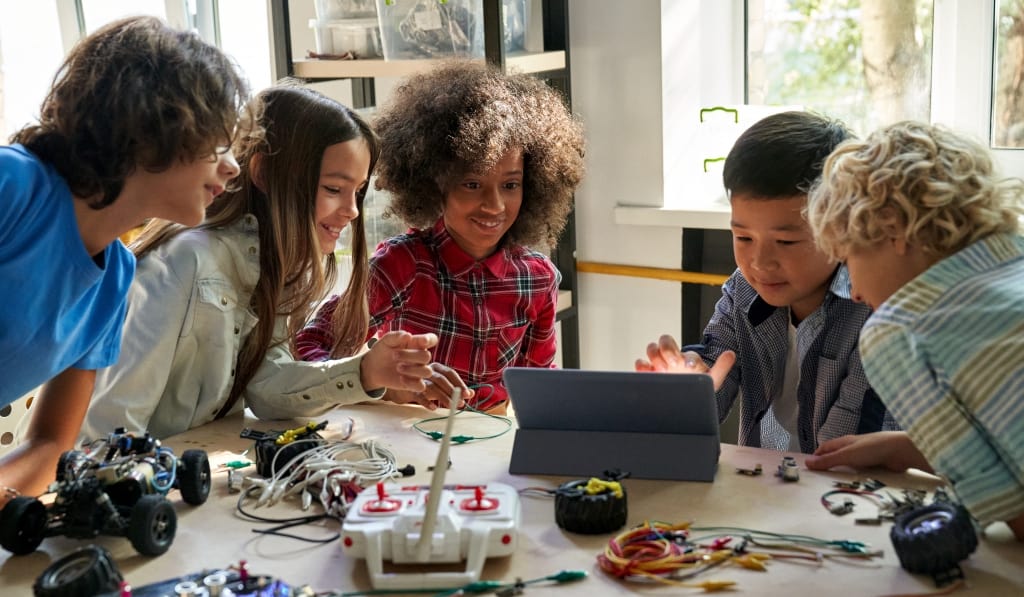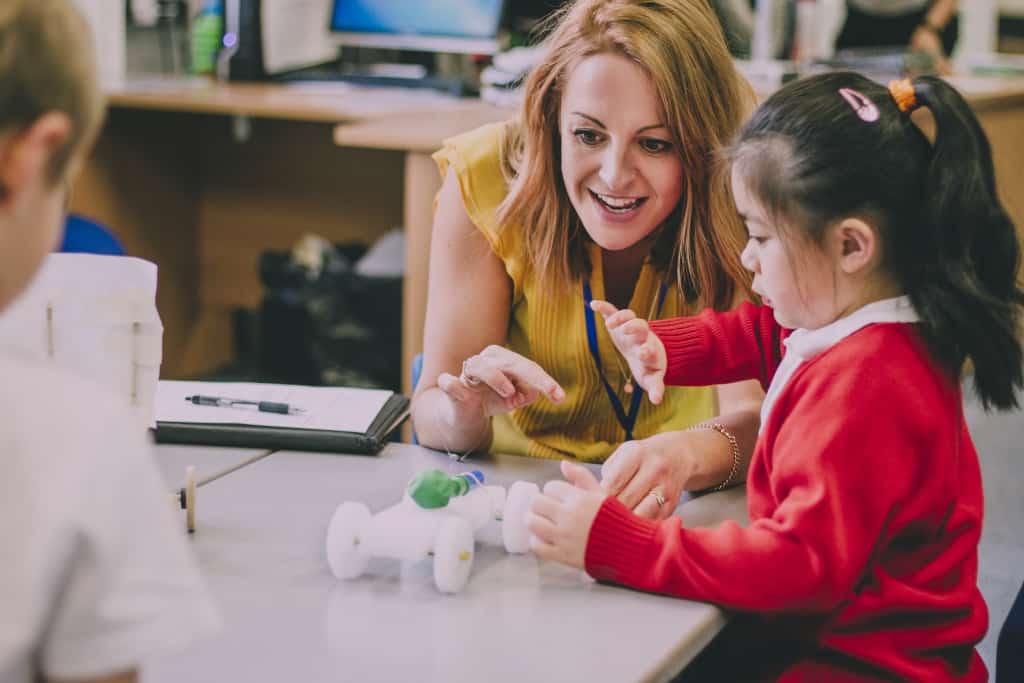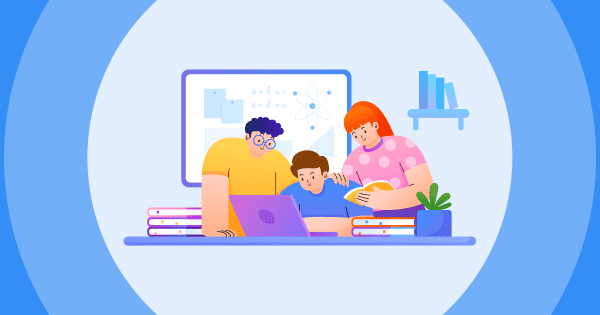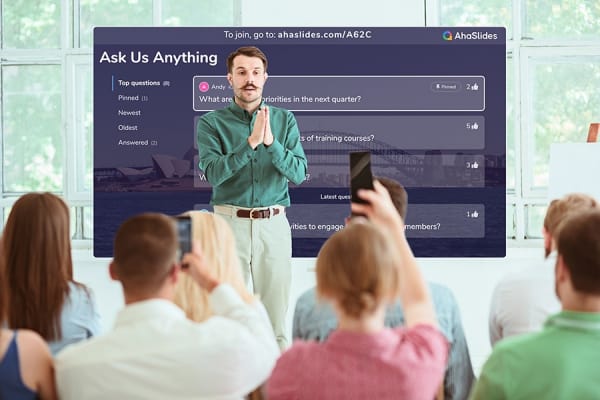何ですか プロジェクトベースの学習私たちの多くが、美術、音楽、演劇などの授業を学生時代で最も楽しい授業だと考えるのには理由があります。
私の学校の木工室、理科実験室、料理教室のキッチンがいつも最も楽しく、生産的で、思い出に残る場所であったのも同じ理由です...
子供たちはただ大好き すること 物事。
自宅で自分の子供が残した壁の「アート」やレゴの瓦礫の山を片付けたことがあるなら、おそらくすでにご存知でしょう。
活動は 重大な 子どもの発達において重要な要素であるにもかかわらず、学校ではあまりにも軽視されがちです。教師やカリキュラムは、聞くことや読むことといった受動的な情報摂取に重点を置いています。
しかし、やって is 学ぶ。 実際、ある研究では、クラスで積極的に物事を行うと、全体的な成績が すごい10%ポイントこれは、生徒に学習させる最も効果的な方法の 1 つであることを証明しています。
要点はこれだ – 彼らにプロジェクトを与え、彼らが開花するのを見てください.
プロジェクトベースの学習の仕組みは次のとおりです。
概要
| プロジェクトベース学習が最初に発見されたのはいつですか? | 1960s |
| 先駆者pプロジェクトベースの学習手法? | バローズとタンブリン |
目次
より良いエンゲージメントのためのヒント

プロジェクトをより適切に管理するための対話型の方法をお探しですか?
次回の会議で使える無料のテンプレートとクイズを入手できます。無料で登録して、AhaSlidesで必要なものを手に入れましょう!
🚀 無料アカウントを取得
プロジェクトベースの学習とは何ですか?
プロジェクトベースの学習 (PBL) は、学生、学生の複数のグループ、またはクラス全体がプロジェクトベースの学習に従事する場合です。 挑戦, 創造的, 達成可能な, 。, 長期的 プロジェクト。
これらの形容詞が太字になっているのは、率直に言って、織物の授業が残り 10 分でパイプクリーナーで動物を作るのは PBL とはみなされないためです。
プロジェクトが PBL の資格を得るには、次の条件を満たす必要があります。 5のもの:
- 挑戦: プロジェクトは、問題を解決するために真剣に考える必要があります。
- クリエイティブ: プロジェクトには、未解決の質問が必要です。 XNUMXつ 正解。 学生は、自分のプロジェクトで創造性と個性を自由に (そして奨励して) 表現する必要があります。
- 達成可能な: プロジェクトは、生徒が授業で知っておくべきことを使用して完了できる必要があります。
- サポート: プロジェクトのニーズ 途中でフィードバックを得る。プロジェクトにはマイルストーンがあり、それを活用してプロジェクトの進捗状況を把握し、アドバイスを提供する必要があります。
- 長期的: プロジェクトは、適切な期間 (数回のレッスンから学期全体まで) 持続するのに十分な複雑さを備えている必要があります。

プロジェクトベースの学習が「プロジェクトベース学習」とも呼ばれるのには理由があります 「発見学習」 および 「体験学習」すべては生徒自身にかかっており、生徒が自分自身の発見と経験を通じてどのように学ぶことができるかが重要です。
不思議ではない 彼らはそれを愛する.
AhaSlidesでブレインストーミングを効率化
なぜプロジェクトベースの学習なのか?
新しいことにコミットする 革新的な教授法 時間はかかりますが、最初のステップは質問することです どうして? 切り替えの最終的な目的、つまり生徒、成績、そして フォーム それから抜け出すことができます。
プロジェクトベースの学習の利点をいくつかご紹介します。
#1 – 本当に効果がある
よく考えてみると、あなたはこれまでの人生ずっとプロジェクトベースの学習をしてきたことに気づくかもしれません。
歩くことを学ぶことはプロジェクトであり、小学校で友達を作ること、初めて食べられる食事を作り、何が一体何なのかを理解することと同じです。 定量締め です。
今、あなたが歩くことができ、友達ができ、漠然と料理をすることができ、経済学の高度な原則を知ることができれば、そこにたどり着くためにあなた自身の PBL に感謝することができます.
そして、あなたはそれが機能することを知っています。
LinkedIn の「インフルエンサー」の 99% が言うように、最高の教えは本の中にあるのではなく、試行、失敗、再試行、そして成功の中にあります。
これがPBLモデルです。学生はプロジェクトが提示する大きな問題に段階的に取り組みます。 たくさん 各段階での小さな失敗。 それぞれの失敗は、彼らが何を間違えたのか、そしてそれを正しくするために何をすべきかを学ぶのに役立ちます。
これは学校で再現される自然な学習プロセスです。PBLが従来の教育方法よりも効果的であることを示唆する証拠が山ほどあるのも不思議ではありません。 データリテラシー、科学、数学、英語、すべて 2 年生から 8 年生までの生徒がいます。
どの段階でもプロジェクトベースの学習は簡単です 効果的な.
#2 – 魅力的である
これらすべての肯定的な結果の理由の多くは、子供たちが PBLで積極的に学びを楽しむ.
これは少し大げさな発言かもしれませんが、考えてみてください。学生として、光子に関する教科書をじっと見つめるか、テスラコイルを自分で作るかという選択肢があったら、どちらにもっと熱中すると思いますか?
上にリンクされた研究はまた、学生がどのように 本当に PBLに取り組んでみましょう。創造性が求められ、やりがいがあり、現実世界ですぐに実践できる課題に直面すると、生徒たちの熱意は飛躍的に高まります。
試験で再現するために情報を暗記することに学生の興味を強制することは不可能です。
彼らに何かを与える 楽しいです そしてモチベーションは自然に治ります。

#3 – 将来性がある
A 2013研究 半数のビジネスリーダーがまともな求職者を見つけられないのは、基本的に、 彼らはどう考えるべきかを知らない.
こうした応募者は技術的なスキルは持っていることが多いが、「適応力、コミュニケーション能力、複雑な問題を解決する能力など、職場での基本能力」が欠けている。
するのは簡単ではありません ソフトスキルを教える 従来の環境ではこのようなことは起こりませんが、PBL では、生徒が知識の面で習得している内容と関連して、これらを習得することができます。
ほとんどプロジェクトの副産物として、学生は協力する方法、障害を乗り越える方法、リードする方法、耳を傾ける方法、意味と動機を持って作業する方法を学びます。
生徒の将来のために、学校でのプロジェクトベースの学習の利点は、労働者と人間の両方にとって明らかになります。
#4 – 包括的である
ジョー・バイデン大統領の教育移行チームのリーダー、リンダ・ダーリング=ハモンド氏はかつてこう言っていました…
「かつて私たちは、プロジェクト型学習を、才能ある生徒向けのコースに通うごく少数の生徒に限定し、いわゆる『思考課題』を与えていました。それがこの国の機会格差を悪化させてきたのです。」
リンダダーリン - ハモンド PBLで。
彼女は、私たちが本当に必要としているのは「このようなプロジェクトベースの学習」だと付け加えた。 を 「学生たち」。
世界中には、社会経済的地位の低さ (低 SES) のために生徒が苦しんでいる学校がたくさんあります。 裕福なバックグラウンドを持つ学生にはすべての機会が与えられ、それらによって前進することができますが、SES の低い学生は真に型枠内に留まります。
現代では、PBL は低 SES の学生にとって優れたレベラーになりつつあります。 全員が同じ土俵に立つことで、 束縛を解く 生徒に完全な創造の自由を与え、上級者とそれほど上級でない生徒が一緒に、内発的動機づけのあるプロジェクトに取り組むことを可能にします。
A Edutopiaによって報告された研究 PBL に切り替えたとき、低 SES の学校でより大きな成長が見られたことがわかりました。 PBL モデルの生徒は、従来の教育を使用している他の学校よりも高い得点と高いモチベーションを記録しました。
この高いモチベーションは非常に重要です。 巨大な 学校は両方とも刺激的であるという低SESの学生のためのレッスン および 同等。 これが早期に学習された場合、これが将来の学習に及ぼす影響は驚異的です。
AhaSlidesで効果的に調査する
プロジェクトベースの学習の例とアイデア
当学校区の 上記の研究 プロジェクトベースの学習の素晴らしい例です。
この研究におけるプロジェクトの一つは、ミシガン州のグレイソン小学校で行われました。そこで、教師は校庭に行って(2年生のクラスは熱心に取り組みました)、見つけた問題をすべてリストアップするというアイデアを導入しました。
学校に戻り、生徒たちが見つけた問題点をすべてリストアップしました。少し話し合った後、先生は地元の市議会に提案書を提出して改善を試みることを提案しました。
見よ、市会議員のランディ・カーターが学校に現れ、生徒たちはクラスとして彼に提案を提示した.
下のビデオでプロジェクトを自分で見ることができます。
そのため、この社会科のクラスでは PBL がヒットしました。 生徒たちは意欲的で、彼らが思いついた結果は、貧困率の高い 2 年生の学校としては目覚ましいものでした。
しかし、他の教科におけるPBLとはどのようなものでしょうか?ご自身の授業でPBLを取り入れてみてはいかがでしょうか?
- 自分の国を作る – グループに分かれて、地球上の位置、気候、国旗、文化、ルールなど、新しい国を考えてみましょう。各項目をどれだけ詳しく書くかは生徒次第です。
- ツアーの旅程を設計する – 世界中の好きな場所を選び、数日間かけて最高のスポットを巡るツアープランを立てましょう。各学生(またはグループ)は予算を守り、交通費、ホテル代、食事代を含めた費用対効果の高いツアーを組む必要があります。ツアーの目的地が地元であれば、 つながる 実生活でのツアー。
- あなたの街にオリンピックの開催地を申請する – オリンピック開催地として、あなたが住んでいる町や都市についてグループで提案書を作成しましょう!観戦場所、宿泊場所、食事、選手のトレーニング場所など、様々なことを検討しましょう。クラス内の各プロジェクトには、同じ予算が割り当てられます。
- アート ギャラリー イベントのデザイン – 展示作品や開催予定のイベントなど、一夜限りのアートプログラムをまとめましょう。各作品の説明を記した小さなプラカードを用意し、ギャラリー全体に作品を配置する構成も工夫しましょう。
- 認知症患者のための特別養護老人ホームを建設する – 認知症村 増加しています。 学生は、認知症村の良さを学び、特定の予算内で居住者をより幸せに保つために必要なすべての施設を備えた村を自分で設計します。
- ミニドキュメンタリーを作る – 解決すべき問題を取り上げ、その問題を探求するドキュメンタリーを制作します。脚本、インタビュー映像、その他生徒が希望する要素をすべて盛り込みます。最終的な目標は、問題を様々な角度から捉え、いくつかの解決策を提示することです。
- 中世の町をデザインする 中世の村人たちの生活を調査し、彼らのために中世の町を設計します。当時の状況と信仰に基づいて町を開発します。
- 恐竜を復活させる – 恐竜のあらゆる種が共存できる惑星を作りましょう。種族間の争いは最小限に抑えるべきなので、生存の可能性を最大限に高めるために惑星を整備する必要があります。
優れたプロジェクトベースの学習への 3 つのレベル
だから、あなたはプロジェクトのための素晴らしいアイデアを持っています. それはすべてのボックスにチェックマークを付けており、学生がそれを気に入っていることがわかります。
PBL がどのように見えるかを分析する時が来ました 全体, 数週間ごと および 毎回のレッスン.
全体像
これがスタートであり、プロジェクトの最終目標です。
もちろん、無作為にプロジェクトを選択し、生徒が最後に抽象的なことを学ぶことを望む自由を持っている教師は多くありません。
標準サーキュラムによると、学生は最終的に、 常に 教えてきたトピックを理解していることを示します。
生徒に与えるプロジェクトを計画する際には、その点を念頭に置いてください。途中で生じる疑問や達成したマイルストーンが、何らかの形で生徒の理解を深めるのに役立つようにしてください。 プロジェクトの主な目的に関連する、そしてその最後に到着する製品は、元の割り当てに対するしっかりした応答です。
発見の旅でこれを忘れてしまい、生徒たちが少し あまりに 創造的すぎて、プロジェクトの主旨を完全に台無しにしてしまったのです。
最終目標を忘れず、生徒の評価に用いるルーブリックを明確にしましょう。効果的な学習のためには、生徒はこれらすべてを理解する必要があります。
ミドルグラウンド
中間地点は、マイルストーンを持つ場所です。
プロジェクトにマイルストーンを散りばめることで、学生は最初から最後まで完全に独力で取り組む必要がなくなります。あなたが彼らにマイルストーンを与えたことで、最終的な成果物は目標にさらに近づくでしょう。 各段階での適切なフィードバック.
重要なことに、これらのマイルストーン チェックは、多くの場合、学生がやる気を感じる時期です。 プロジェクトの進捗状況を登録し、有用なフィードバックを取得し、新しいアイデアを次の段階に進めることができます。
そのため、プロジェクト全体を見て段階に分け、各段階の最後にマイルストーン チェックを行います。
日常
実際のレッスン中に生徒が何をするかという細かい点については、あなたがする必要のあることはあまりありません。 あなたの役割を覚えていることを除いて.
あなたはこのプロジェクト全体のファシリテーターです。 生徒が独立して学習できるように、できるだけ生徒が自分で決定できるようにする必要があります。
それを念頭に置いて、授業は主に…
- 次のマイルストーンと全体的な目標を繰り返します。
- グループの進行状況を確認するテーブル間を移動します。
- 生徒を正しい方向に導くのに役立つ質問をする。
- 褒めて励ます。
- 学生が必要とするものは何でも(理にかなった範囲で)手に入れることができるようにします。
これら 5 つのタスクを確実に完了することで、主役である生徒が実行することで学習する一方で、あなたは素晴らしい脇役になります。

プロジェクトベースの学習へのステップアップ
プロジェクトベースの学習は、正しく行われれば、 万能革命 教育において。
研究によると、成績が大幅に向上することが示されていますが、さらに重要なことは、 好奇心 生徒たちの将来の研究に素晴らしいサービスを提供することができます。
教室でPBLを試してみたい方は、 小さく始める.
まずは短いプロジェクト(例えば1レッスンだけ)を試してみて、クラスの成果を観察してみてはどうでしょうか。また、終了後に簡単なアンケートを実施し、生徒に感想や、もっと大きな規模で取り組みたいかどうかを尋ねるのも良いでしょう。
また、あるかどうかを確認します 他の教師 PBLクラスを試してみたいあなたの学校で。 もしそうなら、一緒に座って、クラスごとに何かをデザインすることができます.
しかし、最も重要なのは、生徒を過小評価しないことです。適切なプロジェクトに取り組めば、生徒たちが驚くほどの成果を上げられるかもしれません。
集まりへの参加をさらに増やす
よくある質問
プロジェクトベース学習の歴史?
プロジェクトベース学習 (PBL) は、ジョン デューイのような教育者が実践的な経験を通じた学習を重視した 20 世紀初頭の進歩的な教育運動にそのルーツがあります。しかし、教育理論家や実践者が深い理解と 20 世紀のスキルを育成するのに PBL が有効であると認識したため、21 世紀から 21 世紀にかけて PBL は大きな注目を集めました。ここ数十年で、PBL は幼稚園から高校までの教育および高等教育で人気の指導アプローチとなり、現実世界の問題解決とコラボレーションを重視する生徒中心の探究ベースの学習への移行を反映しています。
プロジェクトベースの学習とは何ですか?
プロジェクトベース学習 (PBL) は、知識とスキルを学び、応用するために、生徒が現実世界の有意義な実践的なプロジェクトに取り組むことに焦点を当てた指導アプローチです。 PBL では、学生は通常、仲間と協力しながら、特定のプロジェクトや問題に長期間にわたって取り組みます。このアプローチは、アクティブな学習、批判的思考、問題解決、および学術的スキルと実践的スキルの両方の習得を促進するように設計されています。
プロジェクトベース学習の主な特徴は何ですか?
学生中心: PBLでは、生徒自身が学習体験の中心となります。生徒はプロジェクトに主体性を持ち、計画、実行、そして成果の振り返りに責任を持ちます。
本格的なタスク: PBL のプロジェクトは、現実世界の状況や課題を模倣するように設計されています。学生は、特定の分野の専門家が遭遇する可能性のあるタスクに取り組むことが多く、学習体験がより現実的で実践的なものになります。
学際的: PBL では複数の主題分野や分野が統合されることが多く、学生がさまざまな分野の知識を応用して複雑な問題を解決することを奨励します。
問い合わせベース: PBL では、学生が質問し、調査を実施し、解決策を自主的に模索することを奨励します。これにより、好奇心が高まり、主題についてのより深い理解が促進されます。
コラボレーション: 学生は頻繁に仲間と協力し、タスクを分割し、責任を共有し、チームで効果的に働くことを学びます。
クリティカルシンキング: PBL では、生徒が情報を分析し、意思決定を行い、問題を批判的に解決することが求められます。彼らは、解決策に到達するために情報を評価し、総合することを学びます。
コミュニケーションスキル: 学生は多くの場合、自分のプロジェクトを同僚、教師、さらには幅広い聴衆にプレゼンテーションします。これは、コミュニケーションとプレゼンテーションのスキルを向上させるのに役立ちます。
反射: プロジェクトの最後に、学生は学習体験を振り返り、何を学んだか、何がうまくいったか、将来のプロジェクトで何を改善できるかを特定します。
プロジェクトベース学習の成功事例は?
プロジェクトベース学習 (PBL) の最も成功した事例の 2000 つは、カリフォルニア州サンディエゴにあるハイテクハイの学校ネットワークです。 XNUMX 年にラリー ローゼンストックによって設立された High Tech High は、PBL 導入のモデルとして有名になりました。このネットワーク内の学校は、現実世界の問題に取り組む生徒主導の学際的なプロジェクトを優先します。ハイテクハイでは、学生が標準テストで優秀な成績を収め、批判的思考、コラボレーション、コミュニケーションにおける貴重なスキルを獲得し、一貫して優れた学業成績を収めています。その成功により、他の多くの教育機関が PBL 手法を採用し、本格的なプロジェクトベースの学習体験の重要性を強調するようになりました。








